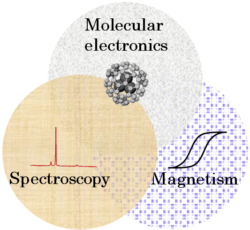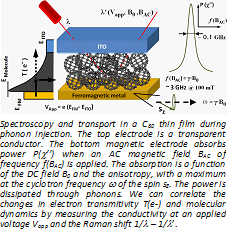Vibronic control in nanoscale molecular devices (Dr. O. Cespedes)
 The size and speed of electronic devices have been exponentially increased in the last few decades thanks to the advances in fundamental science and fabrication processes. Nonetheless, these evermore smaller and faster designs are pushing the fundamental boundaries of quantum mechanics, which will soon result in excessive heating, defective elements and/or impaired processing. Furthermore, there is as well an increasing concern about the environmental and health repercussions of our dependence to electronic appliances. Many of the materials used for the fabrication of semiconducting structures are harmful, and large amounts of hazardous waste are produced every year.
The size and speed of electronic devices have been exponentially increased in the last few decades thanks to the advances in fundamental science and fabrication processes. Nonetheless, these evermore smaller and faster designs are pushing the fundamental boundaries of quantum mechanics, which will soon result in excessive heating, defective elements and/or impaired processing. Furthermore, there is as well an increasing concern about the environmental and health repercussions of our dependence to electronic appliances. Many of the materials used for the fabrication of semiconducting structures are harmful, and large amounts of hazardous waste are produced every year.
Molecular electronics, where we use organic molecules to design new electronic and quasiparticles-based devices, offers the possibility of using to our advantage the same quantum effects that hamper conventional machines. Small intrinsic size, ranging from the quasi 0-dimensional buckyballs to the 2-dimensional graphene, high T superconductivity, degradability, and weak spin-orbit coupling are just some of the extraordinary characteristics of organic materials. However, the research has been focused in emulating standard technologies, rather than developing new functionalities based on these unique properties.
 To make progress in the science and applications of molecular transport, a conceptual step is required. Vibrons are localized vibrations in molecules, from low-frequency (0.1-1 THz) breathing modes where the whole molecule is distorted, to ultrafast hydrogen bond vibrations. To develop new paradigms that use and control vibrons, we can use the power dissipated by magnetic materials during exposure to alternating magnetic fields. The power is dissipated through phonons that will change the vibrations of molecules' attached to the magnet. The conductivity of the molecules is also affected due to structural changes, phonon scattering and assisted tunnelling.
To make progress in the science and applications of molecular transport, a conceptual step is required. Vibrons are localized vibrations in molecules, from low-frequency (0.1-1 THz) breathing modes where the whole molecule is distorted, to ultrafast hydrogen bond vibrations. To develop new paradigms that use and control vibrons, we can use the power dissipated by magnetic materials during exposure to alternating magnetic fields. The power is dissipated through phonons that will change the vibrations of molecules' attached to the magnet. The conductivity of the molecules is also affected due to structural changes, phonon scattering and assisted tunnelling.
In this project, the student will research the quantum transport and vibrational properties of devices fabricated with C60 (buckyballs) and other photoconducting or superconducting molecules. He or she will make use of high and low temperature transport measurements, Raman spectroscopy, ferromagnetic resonance and nanofabrication techniques to design novel structures and techniques that, depending on his/her interests, may lead to discoveries in spintronics, single electron transport, superconductivity, organic solar cells or any of the many possible applications for this exciting topic.
Contact Dr Oscar Céspedes for details.
